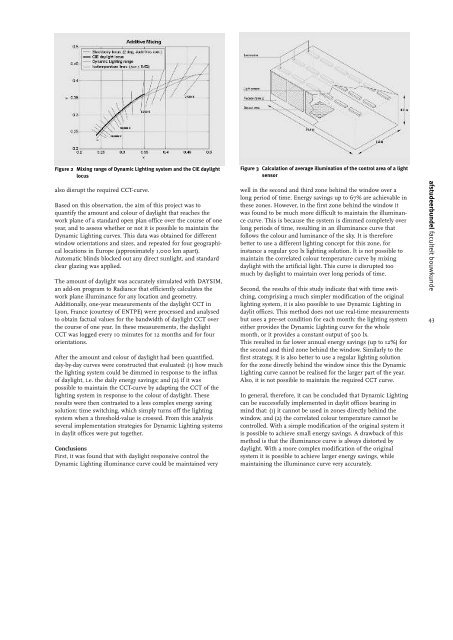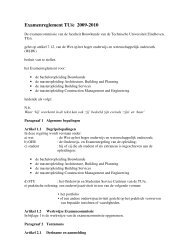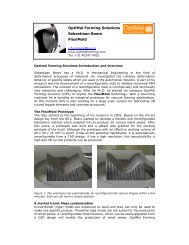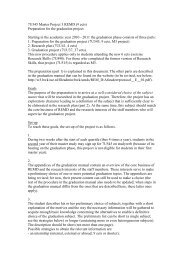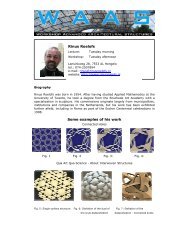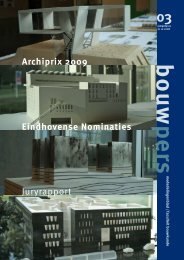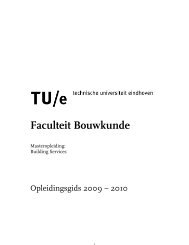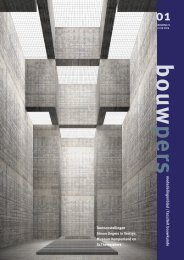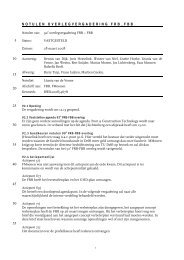afst.bundel 8 MEI 07 - Technische Universiteit Eindhoven
afst.bundel 8 MEI 07 - Technische Universiteit Eindhoven
afst.bundel 8 MEI 07 - Technische Universiteit Eindhoven
You also want an ePaper? Increase the reach of your titles
YUMPU automatically turns print PDFs into web optimized ePapers that Google loves.
Figure 2 Mixing range of Dynamic Lighting system and the CIE daylight<br />
locus<br />
also disrupt the required CCT-curve.<br />
Based on this observation, the aim of this project was to<br />
quantify the amount and colour of daylight that reaches the<br />
work plane of a standard open plan office over the course of one<br />
year, and to assess whether or not it is possible to maintain the<br />
Dynamic Lighting curves. This data was obtained for different<br />
window orientations and sizes, and repeated for four geographical<br />
locations in Europe (approximately 1,000 km apart).<br />
Automatic blinds blocked out any direct sunlight, and standard<br />
clear glazing was applied.<br />
The amount of daylight was accurately simulated with DAYSIM,<br />
an add-on program to Radiance that efficiently calculates the<br />
work plane illuminance for any location and geometry.<br />
Additionally, one-year measurements of the daylight CCT in<br />
Lyon, France (courtesy of ENTPE) were processed and analysed<br />
to obtain factual values for the bandwidth of daylight CCT over<br />
the course of one year. In these measurements, the daylight<br />
CCT was logged every 10 minutes for 12 months and for four<br />
orientations.<br />
After the amount and colour of daylight had been quantified,<br />
day-by-day curves were constructed that evaluated: (1) how much<br />
the lighting system could be dimmed in response to the influx<br />
of daylight, i.e. the daily energy savings; and (2) if it was<br />
possible to maintain the CCT-curve by adapting the CCT of the<br />
lighting system in response to the colour of daylight. These<br />
results were then contrasted to a less complex energy saving<br />
solution: time switching, which simply turns off the lighting<br />
system when a threshold-value is crossed. From this analysis<br />
several implementation strategies for Dynamic Lighting systems<br />
in daylit offices were put together.<br />
Conclusions<br />
First, it was found that with daylight responsive control the<br />
Dynamic Lighting illuminance curve could be maintained very<br />
Figure 3 Calculation of average illumination of the control area of a light<br />
sensor<br />
well in the second and third zone behind the window over a<br />
long period of time. Energy savings up to 67% are achievable in<br />
these zones. However, in the first zone behind the window it<br />
was found to be much more difficult to maintain the illuminance<br />
curve. This is because the system is dimmed completely over<br />
long periods of time, resulting in an illuminance curve that<br />
follows the colour and luminance of the sky. It is therefore<br />
better to use a different lighting concept for this zone, for<br />
instance a regular 500 lx lighting solution. It is not possible to<br />
maintain the correlated colour temperature curve by mixing<br />
daylight with the artificial light. This curve is disrupted too<br />
much by daylight to maintain over long periods of time.<br />
Second, the results of this study indicate that with time switching,<br />
comprising a much simpler modification of the original<br />
lighting system, it is also possible to use Dynamic Lighting in<br />
daylit offices. This method does not use real-time measurements<br />
but uses a pre-set condition for each month: the lighting system<br />
either provides the Dynamic Lighting curve for the whole<br />
month, or it provides a constant output of 500 lx.<br />
This resulted in far lower annual energy savings (up to 12%) for<br />
the second and third zone behind the window. Similarly to the<br />
first strategy, it is also better to use a regular lighting solution<br />
for the zone directly behind the window since this the Dynamic<br />
Lighting curve cannot be realised for the larger part of the year.<br />
Also, it is not possible to maintain the required CCT curve.<br />
In general, therefore, it can be concluded that Dynamic Lighting<br />
can be successfully implemented in daylit offices bearing in<br />
mind that: (1) it cannot be used in zones directly behind the<br />
window, and (2) the correlated colour temperature cannot be<br />
controlled. With a simple modification of the original system it<br />
is possible to achieve small energy savings. A drawback of this<br />
method is that the illuminance curve is always distorted by<br />
daylight. With a more complex modification of the original<br />
system it is possible to achieve larger energy savings, while<br />
maintaining the illuminance curve very accurately.<br />
<strong>afst</strong>udeer<strong>bundel</strong> faculteit bouwkunde<br />
43


